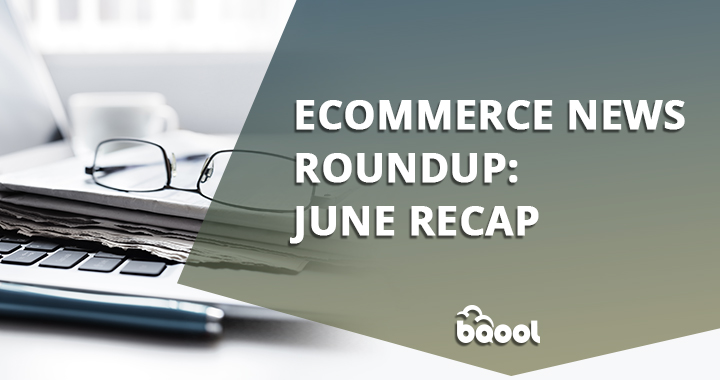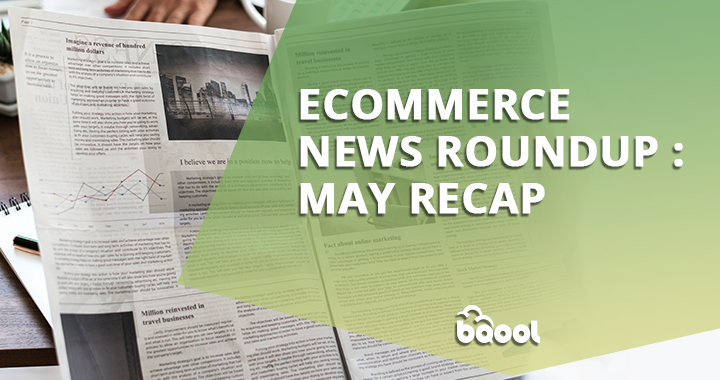Ecommerce News Roundup: June Recap

Here’s a brief summary of the major Amazon news stories in the industry in June 2020. Check it out now!
A+ Content enables copying drafts to other countries
A+ Content has launched a new feature for eligible Professional sellers that automatically copies drafts of newly approved content to your other Amazon marketplaces. Previously, A+ templates needed to be created in each marketplace individually.
This new feature can save sellers a lot of time and effort selling on Amazon’s global marketplaces. You can edit and localize the copied content, translate the language, and submit the content for approval. Cross-country copying automatically applies to content submitted for approval. If you want to cross-country copy any existing content, re-submit it for approval to automatically trigger the process, so you don’t need to recreate an A+ template in each country.
You can also delete a draft in any of your country accounts by clicking on the draft content in the A+ Content Manager, clicking on Actions, and clicking on Delete. This will permanently remove it from your dashboard.
Currently, drafts are copied listed in the following table:
| Source country and language | Copy as draft to |
| US English | CA English, UK English, DE English, IN English, AU English, SG English, BR Portuguese |
| US Spanish | MX Spanish, ES Spanish |
| CA French | FR French |
| MX Spanish | US Spanish, ES Spanish |
| UK English | DE English, FR French, IT Italian, ES Spanish, IN English, AU English, SG English |
| DE German | FR French, IT Italian, ES Spanish |
| DE English | UK English |
| DE Turkish | TR Turkish |
| DE Dutch | NL Dutch |
| NL Dutch | DE Dutch |
| FR French | UK English, DE German, IT Italian, ES Spanish |
| IT Italian | UK English, DE German, FR French, ES Spanish |
| ES Spanish | UK English, DE German, FR French, IT Italian |
| TR Turkish | DE Turkish |
| AE English | SA English, EG English |
| AE Arabic | SA Arabic, EG Arabic |
| SA English | AE English, EG English |
| SA Arabic | AE Arabic, EG Arabic |
| EG English | AE English, SA English |
| EG Arabic | AE Arabic, SA Arabic |
| AU English | SG English |
| SG English | AU English |
See if you’re eligible and learn more about creating A+ Content by clicking on this help page.
Receive too many emails? Learn how to adjust your notification settings.
Common notifications that sellers frequently choose to stop receiving:
- Order Notifications -> Amazon Fulfillment Order Notifications
This email informs you when Amazon processes and ships individual orders. You can get this information through Order Reports in Seller Central or through an API. Learn more here. - Messaging -> Buyer Opt-out
This email informs you that your message cannot be delivered because the buyer has opted out of receiving seller communication. You can get this information through the Buyer-Seller Messaging Service – “Messages” link in the top right hand corner of Seller Central. See more information here.
Note: Learn how to get reviews from opt-out buyers
- Messaging -> Confirmation Notifications
This email informs you that your message to a buyer has been sent. You can also get this information through the Buyer-Seller Messaging Service.
For more information on Notification Preferences and how to review/update, please review this Help page
New Payments dashboard provides sellers an at-a-glance view of their finances
To simplify your financial experience, you can find key information from all your account types on a single page on the new Payments dashboard.
You can access the Payments Dashboard by selecting Payments under the Reports tab. You can learn more about the dashboard through the Take Tour link.
At the top of the page, you can see your Total Balance and Funds Available for disbursement. Select the Account Type and Settlement Period to see components that make up your Total Balance. This includes categories like Sales, Refunds, Expenses, and Account Reserves.
For additional analysis, you will continue to have access to transactions through the Transaction View tab. You can download detailed financial reports through the All Statements and Date Range Report tabs.
Amazon Prime Day will be different this year
Amazon Prime Day usually takes place around mid-July. But the big sale event will be delayed this year mainly due to the devastating impact of Coronavirus pandemic, which resulted in delivery delays and inventory shortage. Amazon is postponing Prime Day 2020 until at least early October, according to the CNBC report. While operations at Amazon warehouses have slowly returned to the normal, the new outbreak hits across the country. Amazon now has to face the threats of operations and logistics again. The exact Prime Day dates will be announced once it gets closer to the event.
COVID-19: Quantity limits removed for shipments to Amazon
Amazon has removed inventory quantity limits to their fulfillment centers. You can restore inventory levels by checking the Restock Inventory page and the Restock report to view the latest recommended replenishment quantities and dates for your products.
To help you ship products from China directly to our fulfillment centers in the US, Amazon has added new and more frequent flight options for you to select through Global Shipping Services. Learn more about the offerings from Global Shipping Services.
For answers to frequently asked questions, visit COVID-19: Update on quantity limits and restock recommendations.
Amazon has some suggestions about product listings for sellers to avoid suspensions
In order to keep your account healthy and avoid suspensions due to customer complaints, Amazon suggests you review our policies and best practices to avoid complaints that a used item has been sold as a new one.
When you list your products, make sure to specify whether they are new or used. Items listed in “New” condition are expected to arrive in brand new, unopened condition with no signs of damage or wear. Sellers receive “Used Sold as New” complaints when buyers complain that the items they received appear to be used, even though the item was listed in new condition. Customers may perceive an item as used if the product packaging has been opened or has come off, if the product contains previous user data, or if the item shows signs of use such as scratches, dirt, or scuffs.
Here are factors you should consider the quality and condition of your products:
- Sourcing: Are you sourcing the product from a trusted supplier that sells items in new condition?
- Listing: Is the product accurately described on Amazon and listed in the correct condition? Have you ensured that there is no ambiguity and the customer is well informed?
- Packaging: Is the product in its original manufacturer packaging as listed on Amazon? Is the packaging robust enough to stay intact throughout the chain from manufacturer to Customer?
- Shipping: Have you taken all appropriate steps and quality checks to ensure that the product is stored, packed, and shipped appropriately, and will not be damaged when shipped?
- Returns: When handling customer returns, are you ensuring that your product still meets “New” condition guidelines before returning it to your inventory?
- See information about Condition Guidelines, Best Practices in Product Authenticity and Quality, and Product Detail Page Rules in Seller Central.
- You can also find guidance on how to add your products and manage your inventory under the “Add your products and manage your inventory”section in Seller University.
Get the latest eCommerce news and Amazon seller tips at blog.bqool.com. Subscribe for updates!








